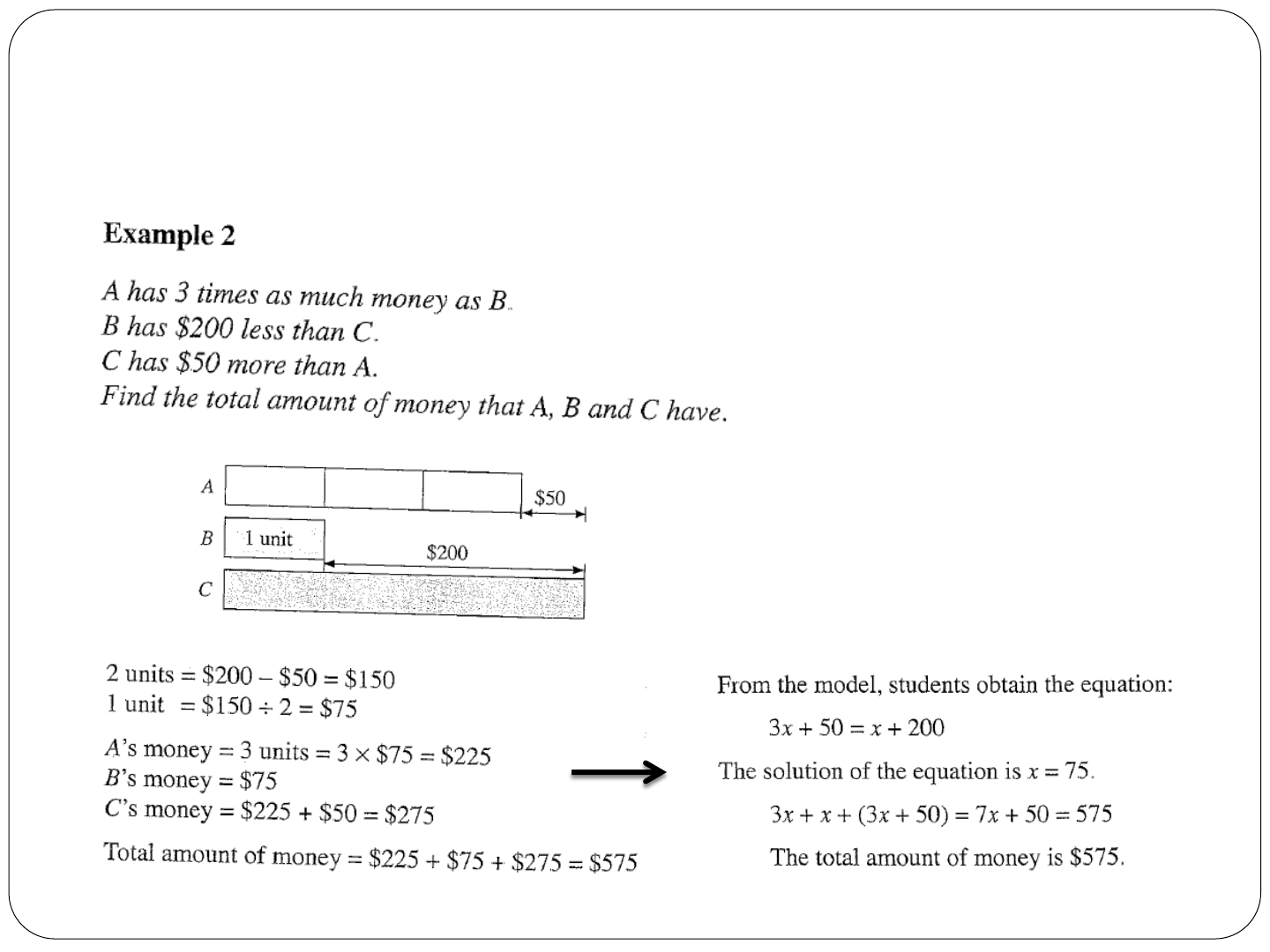
National Council of Teachers of Mathematics (NCTM) Annual
Meeting and Exposition, San Antonio, TX
April 8, 2017
Joseph Sencibaugh, Ph.D., Brooke Callan, and Brennen Almus
Webster University
jsencibaugh77@webster.edu, brookecallan59@webster.edu,
brennenealmus84@webster.edu
Using the Concrete-Representational-Abstract
Technique to Teach Algebra to Students Who
Are Struggling

What Works Clearinghouse:
Best Evidence Encyclopedias
Improving Mathematical Problem Solving Recommendations
Prepare problems and use them in whole-class instruction—
MINIMAL EVIDENCE
Assist students in monitoring and reflecting on the
problem-solving process—STRONG EVIDENCE
Teach students how to use visual representations—
STRONG EVIDENCE
Expose students to multiple problem-solving strategies—
MODERATE EVIDENCE
Help students recognize and articulate mathematical concepts and
notation—MODERATE EVIDENCE
http://ies.ed.gov/ncee/wwc/PracticeGuide.aspx?sid=16

Early Predictors of High School Math
Mastery of fractions and early division is a predictor of students' later success
with algebra and other higher-level mathematics.
Need to focus on whole number division and fractions and teaching them
better.
Math scores on national standardized tests among U.S. high school students
have not improved in three decades and are significantly behind those in
countries such as China, Japan, Finland, the Netherlands and Canada at a time
when math proficiency is a requirement for many jobs.
Noted students who "start ahead in math generally stay ahead" and that those
who "start behind generally stay behind" and it looked to find the reason.
http://www.post-gazette.com/stories/news/education/formula-written-for-
math-success-640962/?p=0

Concrete-Representational-Abstract
Approach
Concrete (Doing Stage). In the concrete stage, the teacher begins
instruction by modeling each mathematical concept with concrete
materials (e.g., red and yellow chips, cubes, base-ten blocks, pattern
blocks, fraction bars, and geometric figures).
Representational (Seeing Stage). In this stage, the teacher transforms the
concrete model into a representational (semi-concrete) level, which may
involve drawing pictures; using circles, dots, and tallies; or using stamps
to imprint pictures for counting.
Abstract (Symbolic Stage). At this stage, the teacher models the
mathematics concept at a symbolic level, using only numbers, notation,
and mathematical symbols to represent the number of circles or groups
of circles. The teacher uses operation symbols (+, –, x, /) to indicate
addition, subtraction, multiplication, or division.

Concrete Level
The CONCRETE LEVEL involves the manipulation of
objects. At this level the learner concentrates on both the
manipulated objects and the symbolic processes.
See the following example (Metz, 2011):

Representational Level
The REPRESENTATIONAL LEVEL involves working with
illustrations of items in performing math tasks.
Items include dots, lines, pictures of objects, or nonsense items.
The emphasis is on developing associations between visual
models and the numerical equations.
See the following example (Metz, 2011):

Abstract Level
The ABSTRACT LEVEL involves the use of numerals, which
is using only numbers to solve math problems.
See the following example (Metz, 2011):

Programs Using CRA Approach
Applied Math Made Easy
Solving Equations: An Algebra Intervention
Hands On Equations
Singapore Math
Math-U-See
Algebra Tiles

Applied Math Made Easy
Solving Equations

Applied Math Made Easy
Solving Equations

Applied Math Made Easy
Solving Equations

Solving Equations: An Algebra Intervention
Solving One-Step Equations

Solving Equations: An Algebra Intervention
Solving One-Step Equations

Solving Equations: An Algebra Intervention
Solving Two-Step Equations

Solving Equations: An Algebra Intervention
Solving Two-Step Equations

Solving Equations: An Algebra Intervention
Solving Two-Step Equations (Like Variables on the Same Side)

Solving Equations: An Algebra Intervention
Solving Two-Step Equations—Like Variables on Opposite Sides

Hands-On Equations
Solving Algebra Equations (Positive Variables and Integers)

Hands-On Equations
Solving Algebra Equations (Positive & Negative Variables and Positive Integers)

Hands-On Equations
Solving Algebra Equations (Positive & Negative Variables and Positive Integers)

Hands-On Equations
Solving Algebra Equations (Positive & Negative Variables and Positive &
Negative Integers)

Hands-On Equations
Solving Algebra Equations (Positive & Negative Variables and Positive &
Negative Integers

Singapore Math
The Model Method and Algebra
Creating and Solving Algebraic Equations

Singapore Math
The Model Method and Algebra
Creating and Solving Algebraic Equations

Singapore Math
The Model Method and Algebra
Creating and Solving Algebraic Equations

Math-U-See
Base 10 & Base X

Math-U-See
Addition of Polynomials

Math-U-See
Multiplication of Polynomials

Math-U-See
Multiplication of Polynomials

Math-U-See
Multiplication of Polynomials

Math-U-See
Multiplication of Polynomials

Math-U-See
Factoring of Polynomials

Math-U-See
Factoring of Polynomials

Math-U-See
Factoring of Polynomials

Math-U-See
Factoring Trinomials

Algebra Tiles
Simplifying Algebraic Expression

Algebra Tiles
Simplifying Algebraic Expression

Algebra Tiles
Solving Linear Equations

Algebra Tiles
Solving Linear Equations

Algebra Tiles
Adding & Subtracting Polynomials

Algebra Tiles
Adding Polynomials

Algebra Tiles
Subtracting Polynomials

Algebra Tiles
Multiplying Polynomials

Algebra Tiles
Multiplying Polynomials

Algebra Tiles
Factoring Trinomials

Algebra Tiles
Factoring Trinomials

References
Borenson, H. (2005). The hands-on equations learning system. Allentown, PA: Borenson and
Associates, Inc. (www.borenson.com)
Curriculum Planning & Development Division Ministry of Education, Singapore. (2009). The
Singapore Model Method for Learning Mathematics. Singapore: EPB Pan Pacific.
(www.singaporemath.com)
Demme, S.P. (2009). Math-U-See (Volume Algebra). Lancaster, PA: Steven P. Demme.
(www.mathusee.com)
Hall, B.C. (1999). Using algebra tiles effectively: Tools for understanding. Upper Saddle River, NJ:
Prentice-Hall Publishing.
Horbas, C., Strauss, T., & Weisse, P. (2010). Applied math made easy. Fond du Lac, WI: AMME,
Inc. (www.ammeinc.com)
Metz, M.L. (2011). Proceedings from NCTM Regional Conference ‘11: Teaching Algebra
Concepts to Students with Special Needs. Albuquerque, NM.
Ministry of Education, Singapore. (2009). The Singapore Model Method for Learning Mathematics.
Singapore: EPB Pan Pacific.
Witzel, B.S., & Riccomini, P.J. (2011). Solving equations: An algebra intervention. Upper Saddle
River, NJ: Pearson Education, Inc.
